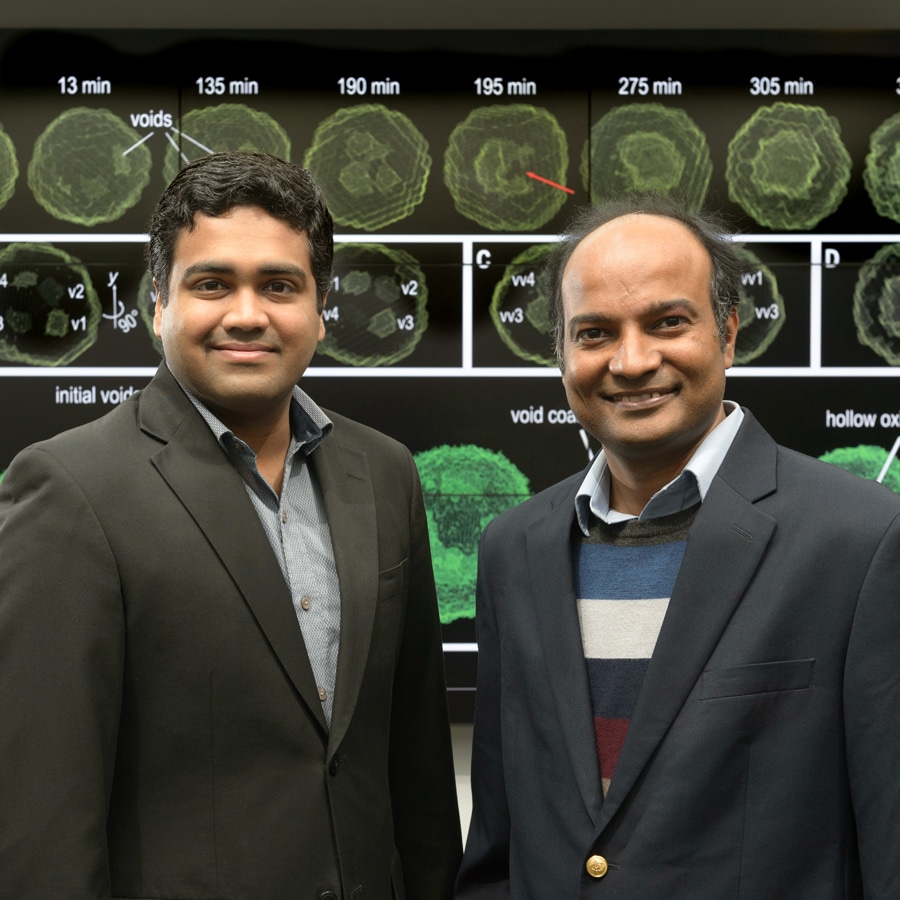Apr 24 2017
 Argonne scientists Badri Narayanan (left) and Subramanian Sankaranarayanan (right) are co-authors of the Science paper, titled �Quantitative 3D Evolution of Colloidal Nanoparticle Oxidation in Solution,� along with the following researchers (not pictured): Yugang Sun, Xiaobing Zuo, Sheng Peng and Ganesh Kamath. (Image by Wes Agresta/Argonne National Laboratory.)
Argonne scientists Badri Narayanan (left) and Subramanian Sankaranarayanan (right) are co-authors of the Science paper, titled �Quantitative 3D Evolution of Colloidal Nanoparticle Oxidation in Solution,� along with the following researchers (not pictured): Yugang Sun, Xiaobing Zuo, Sheng Peng and Ganesh Kamath. (Image by Wes Agresta/Argonne National Laboratory.)
Rust is a sign of neglect. Rust undermines the tools and structures that are used on a daily basis, from cars to buildings and bridges. However, if carefully controlled, the same process that causes rust – metal oxidation – could provide researchers ways to progress advanced drug delivery technologies or battery technologies.
To accomplish such control, researchers will have to first understand precisely how the oxidation process happens. With the help of synchrotrons and supercomputers, researchers at the U.S. Department of Energy’s (DOE) Argonne National Laboratory and Temple University are explaining the process on a finer scale than before.
In a research paper published today in Science, Argonne and Temple University researchers illustrate the behavior of metal nanoparticles by observing them in real time as they oxidized. By using a mix of X-ray scattering and computational simulation, the research team was able to see and model the changes in nanoparticle geometry as they happened.
This knowledge enhances the understanding of basic everyday reactions like corrosion, and constructs a foundation for creating new methods to image, influence, and control such reactions at the atomic scale.
During oxidation of metals, there is a directional flow of material across a solid/gas or solid/liquid interface which can sometimes lead to the formation of holes in the atomic lattice. This process is known as the Kirkendall effect. If well understood, it can be used to design exotic materials at the nanoscale.
Subramanian Sankaranarayanan, Computational Scientist, Argonne’s Center for Nanoscale Materials
In their research, the team was keen to understand the Kirkendall effect in small particles of iron during oxidation at the nanoscale level, precisely in the 10-nanometer range.
At this scale, approximately 10,000 times thinner than a sheet of paper, iron nanoparticles in an oxygen environment display a unique property – they form unusual structures, such as hollowed-out nanoshells or nanoparticles, which already have been employed as vehicles for drug delivery in medicine and as electrodes in battery applications. The structure, shape, and distribution of the holes in these nanoshells rely on how oxidation advances in time.
What we’ve done, through experimental and theoretical approaches, is build an understanding of the process itself — how these holes form and coalesce. Without understanding these processes as they naturally occur, you can never hope to control them to produce new materials with exceptional functionality.
Badri Narayanan, Staff Scientist, Argonne’s Center for Nanoscale Materials
The Argonne study was the first time-resolved investigation to use two X-ray scattering methods to observe structural evolution during nanoparticle oxidation in 3D.
Small-angle X-ray scattering at the Advanced Photon Source aided in the characterization of the void structures, while wide-angle X-ray scattering gave information on the crystalline structure of the nanoparticles. The combination of the two helped the researchers to experimentally examine both the pore structure and metal lattice.
With these experimental methods, the researchers could observe how voids developed at a moderately high spatial resolution, but not one that attained the level of individual atoms. For this understanding, the team turned to the supercomputing resources at the Argonne Leadership Computing Facility.
Computer simulations complemented the experimental observations, which allowed the team to simulate the oxidation of iron nanoparticles atom-by-atom – meaning the researchers were able to see the formation and breakage of bonds and monitor the movement of separate atoms.
X-ray experiments and multimillion-atom reactive simulations were accomplished on exactly the same particle size to enable direct comparison of the developing structure.
We needed the immense computing power of the Argonne Leadership Computing Facility’s 10-petaflop supercomputer, Mira, to perform these large-scale reactive simulations. The simulations provided more detailed insight into the transformation of nanoparticles into nanoshells and the atomic-scale processes that govern their evolution.
Badri Narayanan, Staff Scientist, Argonne’s Center for Nanoscale Materials
The ability to incorporate synthesis and experimental approaches (X-ray imaging and nanoparticle synthesis and transmission electron microscopy done at the Center for Nanoscale Materials) with computer modeling and simulation to form new knowledge is among the most valued aspects of the research, the authors said.
“A full 3D evolution of morphologies of nanoparticles under real reaction conditions with sub-nanometer to atomistic resolution had not been realized until this study,” said Sankaranarayanan. “This truly exemplifies how the sum can be greater than the parts – how theory and imaging together give us information that is better than what can be obtained when these methods are used independently.”
The research paper, titled “Quantitative 3D Evolution of Colloidal Nanoparticle Oxidation in Solution,” is published in Science.
Other authors of this study include Yugang Sun, Xiaobing Zuo, Sheng Peng and Ganesh Kamath. The research was supported by Temple University.
The research was completed using resources at the Advanced Photon Source, the Center for Nanoscale Materials and the Argonne Leadership Computing Facility, as well as the National Energy Research Scientific Computing Center at Lawrence Berkeley National Laboratory – all DOE Office of Science User Facilities. Computing time at the Argonne Leadership Computing Facility was awarded through the Innovative and Novel Computational Impact on Theory and Experiment (INCITE) program and the ASCR Leadership Computing Challenge.